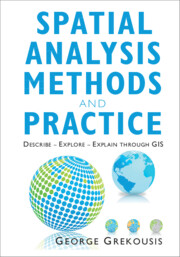Book contents
- Spatial Analysis Methods and Practice
- Reviews
- Spatial Analysis Methods and Practice
- Copyright page
- Contents
- Preface
- 1 Think Spatially
- 2 Exploratory Spatial Data Analysis Tools and Statistics
- 3 Analyzing Geographic Distributions and Point Patterns
- 4 Spatial Autocorrelation
- 5 Multivariate Data in Geography
- 6 Modeling Relationships
- 7 Spatial Econometrics
- References
- Index
3 - Analyzing Geographic Distributions and Point Patterns
Published online by Cambridge University Press: 20 May 2020
- Spatial Analysis Methods and Practice
- Reviews
- Spatial Analysis Methods and Practice
- Copyright page
- Contents
- Preface
- 1 Think Spatially
- 2 Exploratory Spatial Data Analysis Tools and Statistics
- 3 Analyzing Geographic Distributions and Point Patterns
- 4 Spatial Autocorrelation
- 5 Multivariate Data in Geography
- 6 Modeling Relationships
- 7 Spatial Econometrics
- References
- Index
Summary
This chapter deals with
Calculating basic statistics for analyzing geographic distributions including mean center, median center, central feature, standard distance and standard deviational ellipse (centrographics)
Explaining how these metrics can be used to describe spatial arrangements of different sets of point patterns
Defining locational and spatial outliers
Introducing the notions of complete spatial randomness, first-order effects and second-order effects
Analyzing point patterns through average nearest neighbor analysis
Ripley’s K function
Kernel density estimation
Randomness and the meaning of spatial process in creating point patterns
After a thorough study of the theory and lab sections, you will be able to
Use spatial statistics to describe the distribution of point patterns
Identify locational and spatial outliers
Use statistical tools and tests to identify if a spatial point pattern is random, clustered or dispersed
Use Ripley’s K and L functions to define the appropriate scale of analysis
Use kernel density functions to produce smooth surfaces of points’ intensity over space
Apply centrographics, conduct point pattern analysis, apply jernel density estimator and trace locational outliers through ArcGIS
Keywords
- Type
- Chapter
- Information
- Spatial Analysis Methods and PracticeDescribe – Explore – Explain through GIS, pp. 147 - 206Publisher: Cambridge University PressPrint publication year: 2020
- 1
- Cited by



